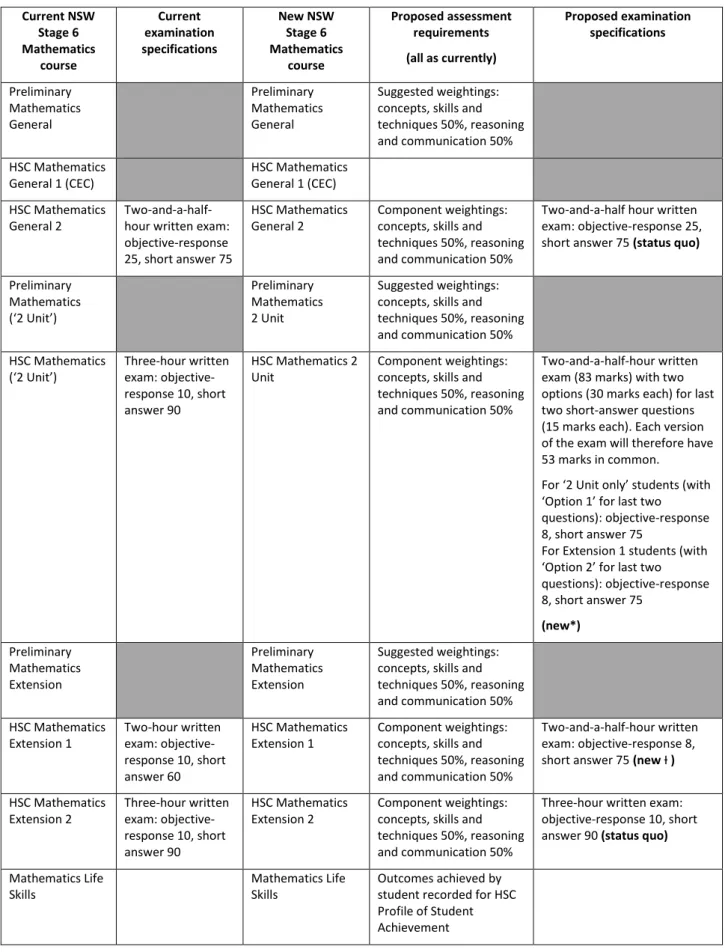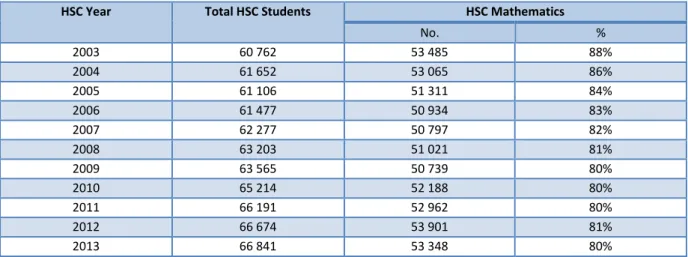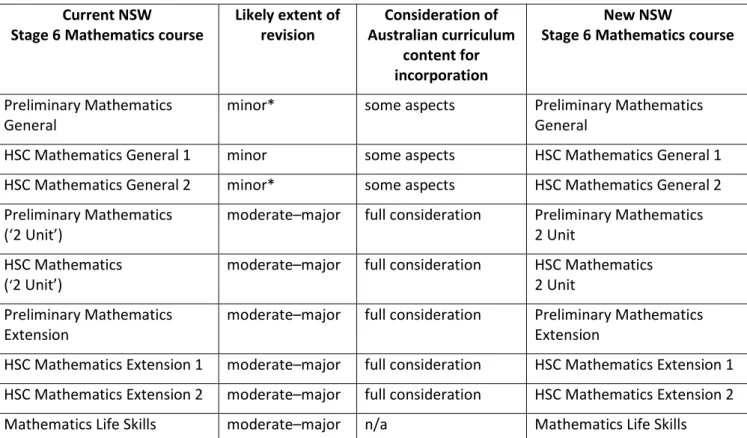For Mathematics ('2 Unit'), Mathematics Expansion 1 and Mathematics Expansion 2 revised HSC exam specifications were also implemented with the HSC 2012. Over the period 2009─2013, there was an overall decrease in the proportion of Mathematics Pre-Education students who completed one or both Mathematics Pre-Education ('2 Unit') and Pre-education. Mathematics Extension courses, while there was a related increase in the proportion studying General Mathematics Preparatory Course and General Mathematics Preparatory Course (2013).
The number of students who have completed the Mathematics pre-education course (‘2 components’) and then switched to General. About 50-60% of the content is studied in the Mathematics ("2 Units") course, while about 5-10% is studied in the Mathematics Extension 1 course.

NSW)
Literature review 1 ACARA literature review
- NSW literature review
- Recent significant developments and practices in Mathematics
In 2006, BOSTES commissioned Dr. Mary Coupland from the Department of Mathematical Sciences, University of Technology, Sydney to write a curriculum review and literature review (available on the BOSTES website) of the 2006-2008 Mathematics Stage 6 Review and Development Project. The curriculum review and literature review were important strategies among a number of data collection strategies used in the first phase of the Mathematics Stage 6 Review and Development Project, Syllabus Review. That the audit takes due account of clarifying the purpose of each course and identifying future learning or professional courses for the intended candidates.
To maintain the nested structure of the current Mathematics ('2 Unit') courses, Mathematics Extension 1 and Mathematics Extension 2 and the calculus basis of these courses. That any revision or development of calculus-based courses maintains the current rigor and level of difficulty of the courses. That, when reviewing the content of mathematics courses at level 6, special attention is paid to the purpose of the Mathematics ('2 Unit') course for students of mathematics only ('2 Unit') and the relevance and relevance of the course content for those students.
That, in considering the use of technology in Stage 6 Mathematics courses, due consideration is given to issues of access and equity. That non-calculation-based Stage 6 Mathematics courses be developed with the view that technology with capabilities beyond the level of scientific calculators will need to be used for aspects of HSC-related examinations. To review the adequacy of current processes for the examination of Mathematics subjects at Stage 6, with particular emphasis on the examination of only Mathematics candidates ('2 Units').
That the syllabus documents within the Phase 6 Mathematics syllabus package contain applications, implications, and considerations for teaching the contents of the syllabus, including with respect to the depth of coverage.
Discussion on the proposed revisions to NSW senior secondary Mathematics courses
The review indicates, in summary, that for both the objectives of post-compulsory Mathematics, the new technologies and Internet access support a much enriched approach. This provided, in broad terms, an indication of the degree of change represented in the Australian Curriculum for NSW and a summary of conceptual issues that would need to be addressed in considering the incorporation of the Australian Curriculum into new NSW senior secondary courses. This will include careful consideration of the Australian Curriculum Mathematics courses and incorporation, where appropriate, of relevant content.
In the 'HSC subject evaluation' of the Stage 6 calculus-based maths courses in 1998, there was an 'overwhelming view, identified through the consultation process, that the current structure of 2/3/4 unit maths should be continued in the near future, with the same indicative time allocation' (240 hours for 2 units, 120 hours for 3 units, 60 hours for 4 units). At the same time, the Mathematics2 Unit course will provide a suitable basis for the study of the Level 6 Mathematics Extension courses. At the same time, the Mathematics Extension 1 course together with the Mathematics 2 Unit course will provide an appropriate basis for the study of the Mathematics Extension 2 course, which will be written to meet the needs of students who have demonstrated excellent ability in .
The course represents a distinctly high level in school mathematics and provides such students with the opportunity to develop significant manipulative skills and a high level of understanding of the fundamental ideas of algebra and calculus. The course therefore provides sufficient foundations for a wide range of useful applications of mathematics, as well as a strong foundation for the further study of the subject. The evaluation and development of the Phase 6 calculus-based courses involves careful consideration of the Australian Mathematics courses curriculum and the inclusion of as wide a range of aspects of the courses as required.
The current package of NSW senior secondary mathematics courses, the possible scope of review of each of these courses, the content review level of the Australian Senior Secondary.
Mathematics course
Assessment and examination specifications
NSW Senior Secondary Review and Evaluation: Mathematics Reference Report 18 Possible structures for the new calculus-based courses, Mathematics 1 Unit, Mathematics Extension 1 and Mathematics Extension 2 are provided in the paper NSW senior secondary review and. Written exam of two and a half hours (83 marks) with two options (30 marks each) for the last two short questions (15 marks each). This approach is designed as a stronger incentive for students to (only) take an introductory calculus-based course and thereby gain a more appropriate background for certain tertiary education fields of study.
The two questions for Supplement 1 students at the end of the paper ("Option 2") would be similar in nature and difficulty to the questions at the end of the paper. Marks obtained by candidates on different versions of the examination paper will be kept separate for BOSTES reporting purposes. The two sets of grades will then be able to be integrated to give a final distribution of grades for scaling purposes, so that, as at present, all students on the same total grade will receive the same scaled point.
The reduced examination time of two and a half hours for the Mathematics 2 unit paper is considered more appropriate for the examination of '2 unit only' candidates, which is equivalent to the examination time for the Mathematics ordinary 2 examination. This will also mean that the total examination time (five hours) for Mathematics Extension 1 candidates is maintained (see Ɨ below). Ɨ The proposed extension of examination time for the Mathematics Extension 1 exam paper is designed to reduce what many perceive as an overemphasis on 'speed' in the current exam and thereby increase the opportunity for the wide range of Mathematics Extension 1 candidates to demonstrate more fully out the level of their knowledge, skills and understanding.

K–12 learning continuum
NSW Senior Secondary Review and Assessment: Mathematics Reference Report 21 The new Mathematics Unit 2 course (moderate – major review of the current course) will be. It will be recommended that, where possible, they also experience the topics on real numbers, algebraic techniques and coordinate geometry, as well as at least some of the trigonometry in Stage 5.3, if not all of the content. The new Preliminary Mathematics Extension and HSC Mathematics Extension 1 courses (moderate – . major revisions of current courses) will be built on the assumption that students have studied the content and achieved the outcomes of the K–10 Mathematics Syllabus up to and including , content and results of Phase 5.3.
It will be recommended that, where possible, they also experience the optional topics on polynomials, logarithms, functions and other graphs, and circular geometry. The new Mathematics Extension 2 course (moderate – major revision of current course) will be built on the assumption that students have completed the new Preliminary Mathematics 2 units and Preliminary Mathematics Extension courses to very high levels of competence. The new maths life skills course (moderate – major revision of current course) will be built on the assumption that the majority of students will have studied life skills outcomes and content at Stage 4 and Stage 5.
Teaching standards and teacher education
The outcomes and content for the pathway have been designed to be quite similar in nature to the outcomes and content of the General Mathematics course in order to be in line with the broad thrust of the 2006-2008 Mathematics Level 6 Review and Development Project 8 which 'the current General Mathematics course material to be largely retained in the structure of the non-calculator-based maths courses at Level 6. At the same time, BOSTES agreed to a longer-term review of the "Unit 2, 3 and 4" courses, which were renamed Maths, Maths Extension 1 and Maths Extension 2 respectively BOSTES has announced that the content and internal assessment arrangements for these courses will be maintained in the initial years of the new HSC.
It is essential that the range of courses meet the needs of the full range of students. In May 2009, the BOSTES approved the release of the outcomes and content of the newly endorsed Mathematics General 1 course for the use of schools in the development or maintenance of Phase 6 School-Designed Board Endorsed Courses (SDBECs) for the GSK. Following the evaluation of the five Stage 6 Mathematics courses of the previous HSC and the decision to maintain the content and internal assessment arrangements of the 'maths-based'.
In 2006, the BOSTES commissioned Dr Mary Coupland from the Department of Mathematical Sciences, University of Technology, Sydney to write a curriculum and literature review for the 2006–2008 Mathematics Stage 6 Review and Development Project. That said, studying the structure, content and assessment arrangements of the mathematics courses of other countries, and those of Australian states and territories, may yield useful ideas for innovations in the NSW situation. It is a time to evaluate the best, preserve and incorporate the best of the new.
In the literature review, Literature Review and Annotated Bibliography to Information the Stage 6 Mathematics Review, for the Mathematics Stage 6 Review and Development Project 2006-2008 Mathematics Stage 6 Review and Development Project, Ph.D. Mary Coupland includes the following summary of the sections “Relevant Learning Theories” and. For both objectives after compulsory mathematics, participation in work and society and further learning, new technologies and access to the Internet support a much richer approach to the study of statistics. It is interesting to note the inclusion of statistics and probability as major components of the new subjects and less emphasis on them.







